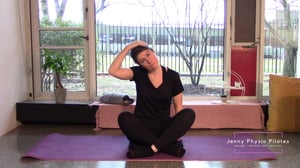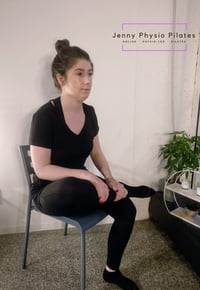We often think of exercise as a means of working on our muscle strength, flexibility and cardiovascular health....but what about our bone health? Bones are a living organism which are continually depositing and re-modelling, which simply means that everyday our body breaks down old bone and creates new bone tissue.
As we age more bone is lost or broken down than is created - this is a normal process of ageing. If we lose too much bone it can lead to a low bone density and a weakness of the bone structure, both characteristics of Osteoporosis. This results in an increase to the fragility of the bone, making it more susceptible to breaking. Osteoporosis is often referred to as a “silent disease” as it usually goes undiagnosed until a fracture occurs from a simple trip or fall that would not usually result in a fracture. The diagnosis is made following a DXA scan and it is classified as mild, moderate or severe, depending on the state of the bone.

Needless to say, falls prevention is one of the most important components in the management of Osteoporosis (you can read tips on how to prevent falls here).
*There is often confusion between osteoporosis and osteoarthritis. To think of it very simply: osteoarthritis is overgrowth of bone and osteoporosis is undergrowth of bone.*
What exactly is Osteopenia?
Osteopenia is really early stage Osteoporosis, when the bone has started to lose density and the structure of the bone has started to weaken. A diagnosis of Osteopenia, by a DXA scan, does not necessarily mean it will progress to Osteoporosis, take it almost as a warning sign - often by making some simple lifestyle changes you can prevent the progression of the disease.
What can you do to reduce the risk of developing Osteopenia & Osteoporosis?
You can incorporate some simple lifestyle changes to prevent the development of Osteopenia or Osteoporosis and also to help manage the disease to prevent it progressing further.
1. Diet
Calcium is required for bone health and Vitamin D is required for our bodies to absorb the Calcium (one needs the other to work effectively). Ensuring you meet recommended daily levels of both of these can reduce the likelihood that you will develop osteoporosis or Osteopenia.
2. Smoking
Smoking can accelerate bone loss and affect the absorption of calcium by the body which is essential for bone health. Reducing or ceasing smoking will help to reduce the risk of developing Osteoporosis.
3. Alcohol
An intake of over 200ml of alcohol per week has been shown to be associated with the development of Osteoporosis.
4. Exercise
Our bodies need weight-bearing exercise to stimulate new bone growth. Exercises focusing on strength and balance have also been shown to reduce the risk of falls, which will reduce the risk of sustaining a fracture.
5. Body Weight
Studies show that low body weight or low body mass, particularly amongst postmenopausal women, increase the likelihood of the development of Osteoporosis.
6. Medications
There are certain medicines that can cause bone loss (e.g. glucocorticoids). If you are on medications and concerned they are affecting your bone health you should discuss this with your doctor.
*In certain circumstances medications or injections may be required in the management of Osteoporosis.
What exercises are good for bone health?
1. Weight-bearing exercises
These types of exercises are essential for bone remodeling. Examples of these include:
- Walking
- Dancing
- Step ups or stair climbing
- Aerobics
- Playing tennis
2. Resistance exercises
Resistance exercises can help to strengthen bones and muscles. These are exercises involving: 
- Working against your own body weight
- Using bands or weights
3. Balance Exercises
Exercises that appropriately challenge your balance have been shown to reduce the risk of a fall or a trip and in turn reduce the risk of a fracture occurring. Examples include:
- Exercises standing on one leg
- Exercises with your feet close together
- Exercises standing on an unstable surface
(see some examples here).
If you would like to incorporate some of these exercises into your routine you can try our two week free trial!
Information based on:
Kanis, J. A., Cooper, C., Rizzoli, R., Reginster, J. Y., & Scientific Advisory Board of the European Society for Clinical and Economic Aspects of Osteoporosis (ESCEO) and the Committees of Scientific Advisors and National Societies of the International Osteoporosis Foundation (IOF) (2019). European guidance for the diagnosis and management of osteoporosis in postmenopausal women. Osteoporosis international : a journal established as result of cooperation between the European Foundation for Osteoporosis and the National Osteoporosis Foundation of the USA, 30(1), 3–44.
Lane N. E. (2006) Epidemiology, etiology, and diagnosis of osteoporosis. Am J Obstet Gynecol. Feb;194(2 Suppl):S3-11.
National Institutes of Health Osteoporosis and Related Bone Diseases National Resource Center (2018). Exercise for Bone Health. NIH Publication No. 18-7879-E.
Irish Osteoporosis Society: www.irishosteoporosis.ie




